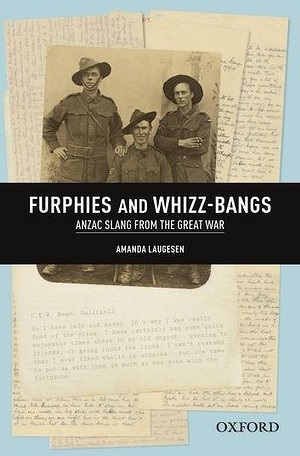‘Words in the trenches: Anzac slang reviewed’, Honest History, 3 March 2015
Paul Daley, author and journalist with Guardian Australia, reviews Furphies and Whizz-bangs: Anzac Slang from the Great War, by Amanda Laugesen
‘Mate, I’m tellin’ yer the point blank is napoo – and so is all our bloody feloosh.’ If you happened to be wandering around the Somme circa 1917, you might have heard an Australian Digger say something like this as he staggered from one of the many estaminets that served the (not so soldierly) behind-the-lines needs of the men.
Needs? Mainly food, alcohol and sex – not necessarily in that order. But unless you were a Digger yourself when you heard this, you might just as well have flown in from Mars, such would have been your understanding of what had just been said. And that’s why you would have found handy Amanda Laugesen’s Furphies and Whizz-Bangs: Anzac Slang from the Great War.
 ‘Point blank’, according to Laugesen’s curious, engaging and compelling book is, ‘A term for white wine. It is an alteration of the French vin blanc, white wine.’ ‘Napoo’, Laugesen meanwhile establishes, means ‘finished, gone, and is a corruption of the French il n’y en a plus, “there’s no more”. Early glossaries of Great War slang suggest that the term was first heard by soldiers when the keepers of the French estaminets replied to their request for drinks.’ Lastly, ‘feloosh … was used during the war to refer to money … This term was in general use by soldiers stationed and serving in the Middle East.’
‘Point blank’, according to Laugesen’s curious, engaging and compelling book is, ‘A term for white wine. It is an alteration of the French vin blanc, white wine.’ ‘Napoo’, Laugesen meanwhile establishes, means ‘finished, gone, and is a corruption of the French il n’y en a plus, “there’s no more”. Early glossaries of Great War slang suggest that the term was first heard by soldiers when the keepers of the French estaminets replied to their request for drinks.’ Lastly, ‘feloosh … was used during the war to refer to money … This term was in general use by soldiers stationed and serving in the Middle East.’
I’m often reluctant to review books associated with war, especially any that opportunistically riff off Anzac. Australia is in the grip of Anzackery – if you’re new to this word try it in the Honest History search engine – and that means that the trickle of mediocre books relating to just about every element of Australian participation in World War I is rapidly becoming a flood.
I’ve written previously about a couple of good and exceptional books. But I don’t see much point in writing about the swamp of bad ones except to issue a general ‘buyer beware’ notification. But having agreed to review Laugesen’s, I’m now saying ‘phew’. It is among the few very good ones. This is yet another book that transcends the traditional division between the genres of so-called academic and popular history. For it is an entertaining and enlightening book that has the capacity to delight both the most hardcore academic military historian – indeed, it may well be indispensable to such a type – and the novice who has little or no previous engagement with writing and history, popular or scholarly, about war.
In fact, if you don’t know much about the Australian engagements in the theatres of Europe and the Ottomans, Furphies and Whizz-Bangs is not such a bad place to start. Read the introduction and go straight to Chapter 7 – place names – and learn precisely where some of the places are whose names are both scattered through our war literature and still evoked in our cultural consciousness. Lone Pine and the Peninsh, Quinn’s Post and Casualty Corner, Moo-cow Farm and Plugstreet are all plotted and, for the most party, etymologically explained. Then read further about these places.
A thing about place names: they can sound so deceptively benign and connote an emotional response totally at odds with their history. Moo-cow Farm? I’m imagining I’m in the Bega Valley on a sunny winter’s day, traipsing through a lush paddock as the Holstein Friesians lift their heads, chew cud and observe the passing me with their big brown eyes.
If only. In fact Moo-cow Farm was the name the Australians gave Mouquet Farm near Pozieres. In six weeks in August and September 1916, the fighting in and around Pozieres, including Mouquet Farm, claimed 23,000 Australian casualties, including 6800 dead. Moo-cow Farm indeed. Those diggers really were laconic and ironic, and that is evident throughout Laugesen’s book as the meaning of so many slang terms is explained.
While this is the sort of book that can be read start to finish, one of its great attributes is that it can also make sense when opened on almost any page. This in no way belies the work of great scholarship that underlies it. The author has meticulously scoured years of archival newspaper reports, publications for soldiers, and the diaries and letters of the Diggers themselves to understand and explain the etymology of the slang words she lists. She has also researched from and generously cited the earliest works on soldier slang, including WH Downing’s Digger Dialects and Brophy and Partridge’s Songs and Slang of the British Soldier: 1914-1918.
A small and elegant production, Furphies and Whizz-Bangs is what I’d call a talking point book: it can sit on your coffee-table where you can easily dip into it during an ad break and demand of your 16-year-old son, ‘Hey mate, you working the Nut [scheming/malingering]?’ Or you can read it as a companion to some of the other worthwhile books, new and old, that have been produced about Australia’s World War I experience.


Leave a Reply
You must be logged in to post a comment.